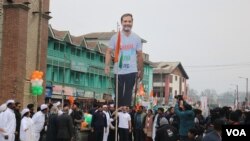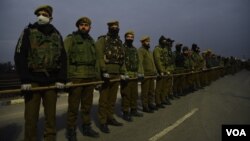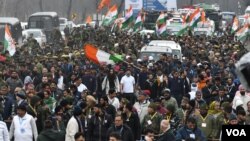The streets of Srinagar reverberated with the slogans of “End Hatred, Unite India” and “Hail Mother India” on Sunday as thousands of people from different parts of India marched together to mark the end of a nationwide “Bharat Jodo Yatra” or “Unite India” March in Indian-administered Kashmir.
Tight security arrangements were made in the region to prevent violence and ensure the march came to a peaceful conclusion. Residents were barred from moving outside as strict restrictions were imposed at multiple locations in Srinagar, the region's capital city.
The 135-day march was organized to protest the Hindu nationalist policies of the ruling Bharatiya Janata Party. The Indian National Congress, or INC, the country’s largest opposition party, kicked off the march in September from Kanyakumari, a coastal town of the south Indian state, Tamil Nadu.
Rahul Gandhi, a member of parliament and the former president of INC, led the 4,080 kilometers journey across the country. Millions of people joined the caravan for periods of time as the procession of 118 permanent travelers moved through 75 districts of various Indian states, according to Jairam Ramesh, media spokesman for INC.
“I learnt a lot during the march after having interactions with thousands of the countrymen. The aim of conducting this march was to end the hatred that is being spread in the country,” Gandhi told reporters during a news conference.
He was referring to alleged persecution of minorities and other communities living in India under the BJP government led by Prime Minister Narendra Modi.
“This march has given the people of India an alternative vision of love, peace and a chance to embrace each other,” said Gandhi. “BJP and [Hindu extremist party] RSS have given a vision full of hatred, arrogance and violence,” he said.
The BJP has not responded to Gandhi’s remarks.
The “Unite India” march entered Indian-Administered Jammu and Kashmir, or J&K, on 20th January. The procession moved for three days all along the hilly terrain to enter the Muslim-majority Kashmir region after spending a couple of days in the Hindu-dominated Jammu division of the Himalayan territory.
Two former chief ministers of J&K, Omar Abdullah of National Conference and Mehbooba Mufti of Peoples Democratic Party, welcomed the Gandhi-led caravan at different locations inside the valley.
The march finally ended at Lal Chowk neighborhood of Srinagar after Gandhi hoisted the Indian national flag in presence of his sister who happens to be the general secretary of INC, Priyanka Gandhi Vadra.
“Had situations in Kashmir improved, then targeted [civilian] killings wouldn’t have happened,” Gandhi said. “People in J&K and Ladakh are unhappy.”
Upcoming elections
People who accompanied Gandhi during the march sang anthems and shouted slogans against BJP.
“Time for the Modi government is up,” Ranbir Singh, a former professor and head of the political science department at Maharshi Dayanand University told VOA. “People of India have realized that they cannot support a party that spreads hate, promotes corruption, does not respect the constitution and the idea of India,” he said, adding that he joined the march in three different states -- Rajasthan, Haryana and J&K.
Singh predicted the march will have an impact on Indian politics this year, as elections in nine different states are scheduled in 2023.
“People will teach BJP a lesson of their life,” Singh said. “The results of the elections would be the clear reflection of the Unite India March.”
Avni Bansal, a resident of Madhya Pradesh and a lawyer at Indian Supreme Court in New Delhi, said that to her, the march was similar to a pilgrimage, aimed at redrawing the spirit of India.
“BJP and RSS have complexly politicized and changed the meaning of what India is,” Bansal said. “I think more than anything else, this was our attempt to spread the message of love and fight for what India truly is, which is a liberal fraternity, quality, equality, progressive nation,” she said.
Altaf Thakur, spokesperson of the Kashmir wing of BJP, said the INC should rename its march to the “Forgive INC” march. He said India’s troubles result from the party’s long rule, starting in 1947, the year India and its rival neighboring country Pakistan gained its independence from British rule.
“On 5 August 2019 India got united,” he told VOA, referring to the day the BJP government removed the special status granted to J&K. “The foot-march is nothing but a publicity stunt and an attempt to revive Gandhi family in India,” he said.
He added that if seen practically the person who united “India is none other than Narendra Modi.”
The INC invited the leaders of 23 likeminded opposition parties to attend a ceremony to celebrating the completion of the “Unite India” march.
Leaders from several opposition parties across India and J&K took part in the event on Monday, though some could attend due to heavy snowfall.
Mohammed Muzaffar Shah, vice president of the Awami National Conference, a regional political party, said many parties joined the march in the hope of easing hatred for Muslims, Christians and “untouchable” people called Dalits that he believes has spread under BJP rule.
“I see the majority of the people in India are not communal” -- meaning highly factional -- “and that is why they are out to strengthen the march,” he told VOA before the ceremony.









